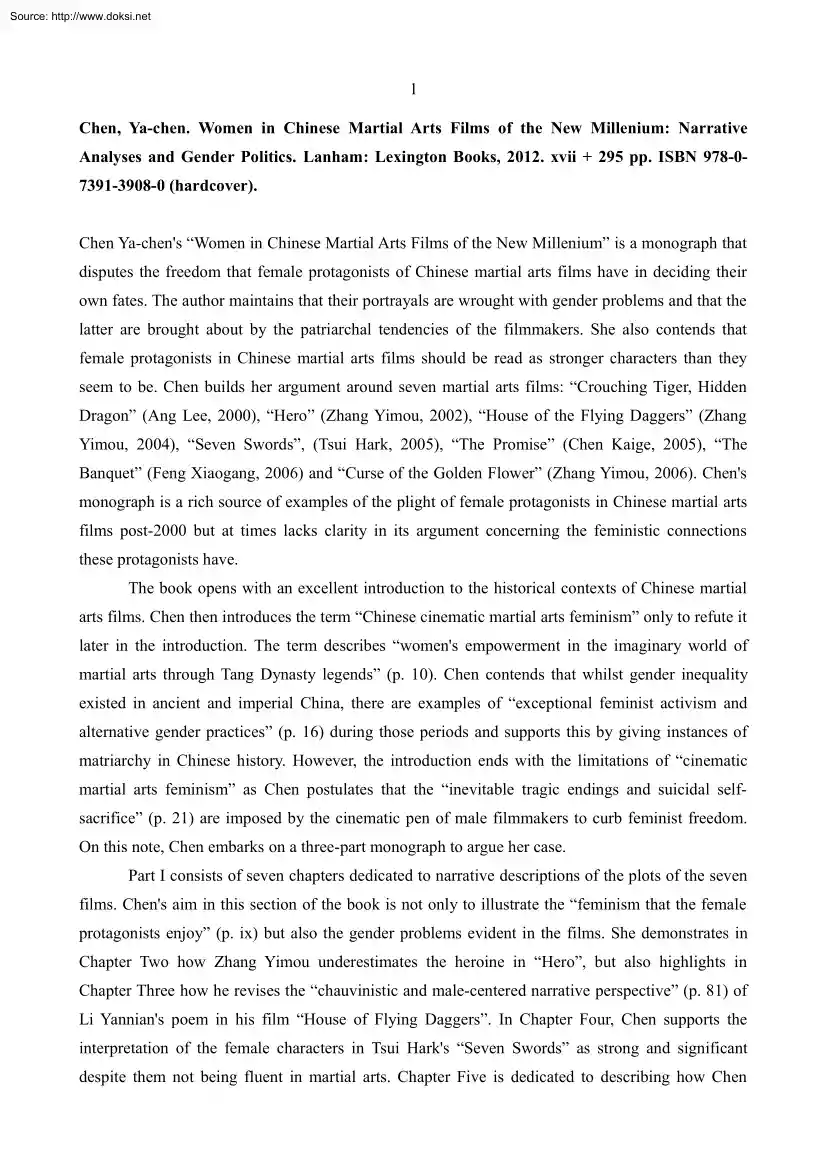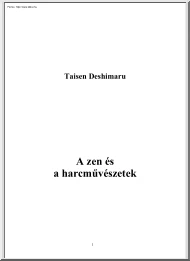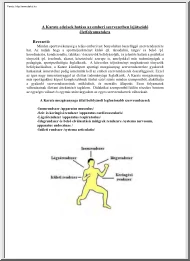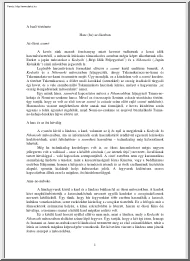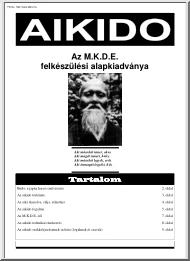Datasheet
Year, pagecount:2014, 3 page(s)
Language:English
Downloads:2
Uploaded:July 11, 2019
Size:520 KB
Institution:
-
Comments:
Attachment:-
Download in PDF:Please log in!
Comments
No comments yet. You can be the first!Most popular documents in this category
Content extract
Source: http://www.doksinet 1 Chen, Ya-chen. Women in Chinese Martial Arts Films of the New Millenium: Narrative Analyses and Gender Politics. Lanham: Lexington Books, 2012 xvii + 295 pp ISBN 978-07391-3908-0 (hardcover) Chen Ya-chens “Women in Chinese Martial Arts Films of the New Millenium” is a monograph that disputes the freedom that female protagonists of Chinese martial arts films have in deciding their own fates. The author maintains that their portrayals are wrought with gender problems and that the latter are brought about by the patriarchal tendencies of the filmmakers. She also contends that female protagonists in Chinese martial arts films should be read as stronger characters than they seem to be. Chen builds her argument around seven martial arts films: “Crouching Tiger, Hidden Dragon” (Ang Lee, 2000), “Hero” (Zhang Yimou, 2002), “House of the Flying Daggers” (Zhang Yimou, 2004), “Seven Swords”, (Tsui Hark, 2005), “The Promise” (Chen Kaige, 2005),
“The Banquet” (Feng Xiaogang, 2006) and “Curse of the Golden Flower” (Zhang Yimou, 2006). Chens monograph is a rich source of examples of the plight of female protagonists in Chinese martial arts films post-2000 but at times lacks clarity in its argument concerning the feministic connections these protagonists have. The book opens with an excellent introduction to the historical contexts of Chinese martial arts films. Chen then introduces the term “Chinese cinematic martial arts feminism” only to refute it later in the introduction. The term describes “womens empowerment in the imaginary world of martial arts through Tang Dynasty legends” (p. 10) Chen contends that whilst gender inequality existed in ancient and imperial China, there are examples of “exceptional feminist activism and alternative gender practices” (p. 16) during those periods and supports this by giving instances of matriarchy in Chinese history. However, the introduction ends with the limitations of
“cinematic martial arts feminism” as Chen postulates that the “inevitable tragic endings and suicidal selfsacrifice” (p. 21) are imposed by the cinematic pen of male filmmakers to curb feminist freedom On this note, Chen embarks on a three-part monograph to argue her case. Part I consists of seven chapters dedicated to narrative descriptions of the plots of the seven films. Chens aim in this section of the book is not only to illustrate the “feminism that the female protagonists enjoy” (p. ix) but also the gender problems evident in the films She demonstrates in Chapter Two how Zhang Yimou underestimates the heroine in “Hero”, but also highlights in Chapter Three how he revises the “chauvinistic and male-centered narrative perspective” (p. 81) of Li Yannians poem in his film “House of Flying Daggers”. In Chapter Four, Chen supports the interpretation of the female characters in Tsui Harks “Seven Swords” as strong and significant despite them not being fluent
in martial arts. Chapter Five is dedicated to describing how Chen Source: http://www.doksinet 2 Kaige “rethinks, problematises, revises and cinematises” (pp. 108-109) the fairytale archetypes of “Cinderella”, “Sleeping Beauty” and “Snow White” in his film “The Promise”. In Chapter Six, Chen explains how filmmaker Feng Xiaogang in his film “The Banquet” rewrites the destinies of Shakespeares Ophelia and the Queen of Denmark in the characters of Qing Nü and Waner. In Chapter Seven, the author highlights the gender problems that the female protagonists of Zhang Yimous “Curse of the Golden Flower” are faced with by drawing parallels between the character of the queen and the “mad woman in the attic” in Charlotte Brontës “Jane Eyre”. Chen, however, ends the chapter by stating that the female characters in Zhangs film are, despite these negative portrayals, “ambitious and politically skillful in initiating their political careers” (pp. 146) Part
II is where the author attempts to argue the limitations of “cinematic martial arts feminism” by exposing the “glass ceiling” (ibid). In Chapter Eight, Chen covers female sacrifice in the context of three films and argues that this theme has been deliberately created by male filmmakers. She maintains that although women fulfill their wishes in martial arts films, these wishes tend to be self-destructive and reflect the filmmakers unconscious desire to cinematically dominate the female protagonist. In the next chapter, the author problematises the phallocentricism in teacher-student relationships in four of the films. She argues that the male teachers take on a higher social status from which they educated women to accept roles of lower social status. In Chapter Ten, Chen compares the “puppeteering” of the female protagonists by the filmmakers to Platos Cave in “The Republic”. She points out that it is the “directors control of everything on the screen” that is the
“glass ceiling” (p. 204) Just like Platos prisoners who turn their heads to see what is behind them in the cave, discerning viewers can see the manipulation of the filmmakers (ibid). Chens monograph ends with Part III, which is dedicated to interviews conducted with persons in the Chinese film industry. Transcripts of interviews with screenwriters Chung Ling and Tsai Kuo-jung, fifth-generation filmmaker, Pan Hua and judge at the Taipei Golden Horse Film Festival, Wang Wei, are to be found in four chapters. Pan Hua, classmate of fifth-generation filmmakers like Chen Kaige and Zhang Yimou, sheds light on the possibly patriarchal personalities of the filmmakers responsible for the films discussed. The interviewees mainly agree with Chens proposition that there are limitations to the freedom of female protagonists in the films but also attempt to explain why this is so. They explain how investors have a huge say in the final form of the script. Practical financial concerns take
precedence over any feminist questions raised by female screenwriters or actresses. The interviewees also mention how producers favour male over female actors because they bring in more financial investments. All in all, Chen Ya-chens monograph is strong in its detailed narrative analyses of female Source: http://www.doksinet 3 protagonist representations in Chinese martial arts films and in its data collection from persons within the Chinese film industry. However, it has a few weak points The connections that Chen makes between feminism and female protagonists who do not abide by the patriarchal order in martial arts films are often misleading. It appears that she is trying to draw attention to filmic representations of female protagonists in martial arts films set in ancient China that embody feministic ideals. However, her tendency to use the term “feminism” as a process set within ancient China misleads the reader into thinking that the feminism that we know of today
already existed during those periods in Chinese history. Furthermore, whilst it is valid for Chen to highlight instances within the films of the disadvantaged stances that female protagonists face, the connection that she makes between the intention of the filmmaker and the dominant male hand in determining the fate of female characters is difficult to discern since there is little evidence of that in the book. Nonetheless, Chen Ya-chens work is a detailed documentation of female protagonists in martial arts films that both defies and supports the view that fictional martial arts worlds allow female literary characters to escape patriarchal conventions in ancient China. This book is a welcome addition to feminist film theory and Chinese cinema. (Joann Huifen Hu, Jacobs University Bremen, Germany)
“The Banquet” (Feng Xiaogang, 2006) and “Curse of the Golden Flower” (Zhang Yimou, 2006). Chens monograph is a rich source of examples of the plight of female protagonists in Chinese martial arts films post-2000 but at times lacks clarity in its argument concerning the feministic connections these protagonists have. The book opens with an excellent introduction to the historical contexts of Chinese martial arts films. Chen then introduces the term “Chinese cinematic martial arts feminism” only to refute it later in the introduction. The term describes “womens empowerment in the imaginary world of martial arts through Tang Dynasty legends” (p. 10) Chen contends that whilst gender inequality existed in ancient and imperial China, there are examples of “exceptional feminist activism and alternative gender practices” (p. 16) during those periods and supports this by giving instances of matriarchy in Chinese history. However, the introduction ends with the limitations of
“cinematic martial arts feminism” as Chen postulates that the “inevitable tragic endings and suicidal selfsacrifice” (p. 21) are imposed by the cinematic pen of male filmmakers to curb feminist freedom On this note, Chen embarks on a three-part monograph to argue her case. Part I consists of seven chapters dedicated to narrative descriptions of the plots of the seven films. Chens aim in this section of the book is not only to illustrate the “feminism that the female protagonists enjoy” (p. ix) but also the gender problems evident in the films She demonstrates in Chapter Two how Zhang Yimou underestimates the heroine in “Hero”, but also highlights in Chapter Three how he revises the “chauvinistic and male-centered narrative perspective” (p. 81) of Li Yannians poem in his film “House of Flying Daggers”. In Chapter Four, Chen supports the interpretation of the female characters in Tsui Harks “Seven Swords” as strong and significant despite them not being fluent
in martial arts. Chapter Five is dedicated to describing how Chen Source: http://www.doksinet 2 Kaige “rethinks, problematises, revises and cinematises” (pp. 108-109) the fairytale archetypes of “Cinderella”, “Sleeping Beauty” and “Snow White” in his film “The Promise”. In Chapter Six, Chen explains how filmmaker Feng Xiaogang in his film “The Banquet” rewrites the destinies of Shakespeares Ophelia and the Queen of Denmark in the characters of Qing Nü and Waner. In Chapter Seven, the author highlights the gender problems that the female protagonists of Zhang Yimous “Curse of the Golden Flower” are faced with by drawing parallels between the character of the queen and the “mad woman in the attic” in Charlotte Brontës “Jane Eyre”. Chen, however, ends the chapter by stating that the female characters in Zhangs film are, despite these negative portrayals, “ambitious and politically skillful in initiating their political careers” (pp. 146) Part
II is where the author attempts to argue the limitations of “cinematic martial arts feminism” by exposing the “glass ceiling” (ibid). In Chapter Eight, Chen covers female sacrifice in the context of three films and argues that this theme has been deliberately created by male filmmakers. She maintains that although women fulfill their wishes in martial arts films, these wishes tend to be self-destructive and reflect the filmmakers unconscious desire to cinematically dominate the female protagonist. In the next chapter, the author problematises the phallocentricism in teacher-student relationships in four of the films. She argues that the male teachers take on a higher social status from which they educated women to accept roles of lower social status. In Chapter Ten, Chen compares the “puppeteering” of the female protagonists by the filmmakers to Platos Cave in “The Republic”. She points out that it is the “directors control of everything on the screen” that is the
“glass ceiling” (p. 204) Just like Platos prisoners who turn their heads to see what is behind them in the cave, discerning viewers can see the manipulation of the filmmakers (ibid). Chens monograph ends with Part III, which is dedicated to interviews conducted with persons in the Chinese film industry. Transcripts of interviews with screenwriters Chung Ling and Tsai Kuo-jung, fifth-generation filmmaker, Pan Hua and judge at the Taipei Golden Horse Film Festival, Wang Wei, are to be found in four chapters. Pan Hua, classmate of fifth-generation filmmakers like Chen Kaige and Zhang Yimou, sheds light on the possibly patriarchal personalities of the filmmakers responsible for the films discussed. The interviewees mainly agree with Chens proposition that there are limitations to the freedom of female protagonists in the films but also attempt to explain why this is so. They explain how investors have a huge say in the final form of the script. Practical financial concerns take
precedence over any feminist questions raised by female screenwriters or actresses. The interviewees also mention how producers favour male over female actors because they bring in more financial investments. All in all, Chen Ya-chens monograph is strong in its detailed narrative analyses of female Source: http://www.doksinet 3 protagonist representations in Chinese martial arts films and in its data collection from persons within the Chinese film industry. However, it has a few weak points The connections that Chen makes between feminism and female protagonists who do not abide by the patriarchal order in martial arts films are often misleading. It appears that she is trying to draw attention to filmic representations of female protagonists in martial arts films set in ancient China that embody feministic ideals. However, her tendency to use the term “feminism” as a process set within ancient China misleads the reader into thinking that the feminism that we know of today
already existed during those periods in Chinese history. Furthermore, whilst it is valid for Chen to highlight instances within the films of the disadvantaged stances that female protagonists face, the connection that she makes between the intention of the filmmaker and the dominant male hand in determining the fate of female characters is difficult to discern since there is little evidence of that in the book. Nonetheless, Chen Ya-chens work is a detailed documentation of female protagonists in martial arts films that both defies and supports the view that fictional martial arts worlds allow female literary characters to escape patriarchal conventions in ancient China. This book is a welcome addition to feminist film theory and Chinese cinema. (Joann Huifen Hu, Jacobs University Bremen, Germany)
